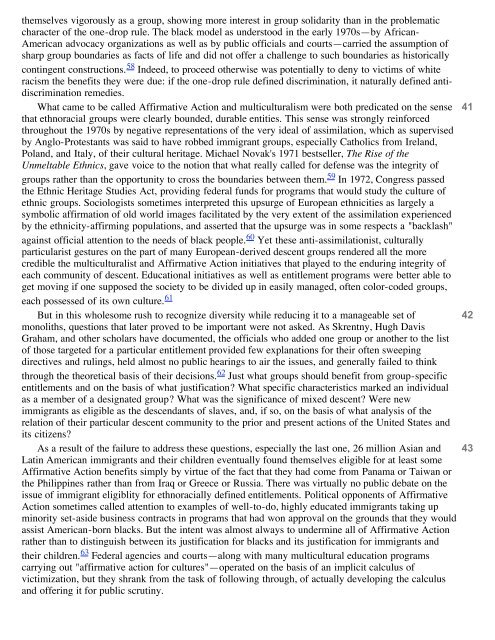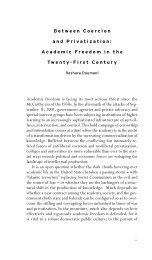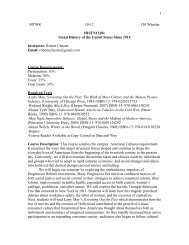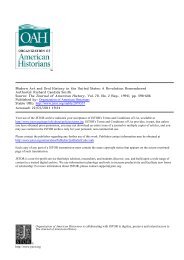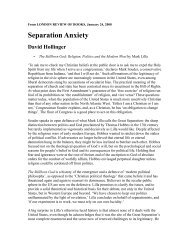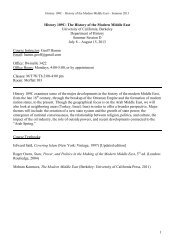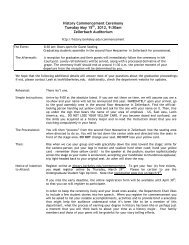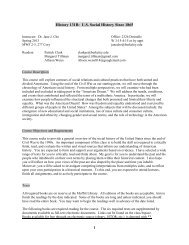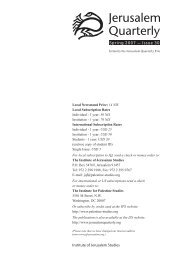David A. Hollinger | Amalgamation and Hypodescent: The Question ...
David A. Hollinger | Amalgamation and Hypodescent: The Question ...
David A. Hollinger | Amalgamation and Hypodescent: The Question ...
You also want an ePaper? Increase the reach of your titles
YUMPU automatically turns print PDFs into web optimized ePapers that Google loves.
themselves vigorously as a group, showing more interest in group solidarity than in the problematiccharacter of the one-drop rule. <strong>The</strong> black model as understood in the early 1970s—by African-American advocacy organizations as well as by public officials <strong>and</strong> courts—carried the assumption ofsharp group boundaries as facts of life <strong>and</strong> did not offer a challenge to such boundaries as historicallycontingent constructions. 58 Indeed, to proceed otherwise was potentially to deny to victims of whiteracism the benefits they were due: if the one-drop rule defined discrimination, it naturally defined antidiscriminationremedies.What came to be called Affirmative Action <strong>and</strong> multiculturalism were both predicated on the sense 41that ethnoracial groups were clearly bounded, durable entities. This sense was strongly reinforcedthroughout the 1970s by negative representations of the very ideal of assimilation, which as supervisedby Anglo-Protestants was said to have robbed immigrant groups, especially Catholics from Irel<strong>and</strong>,Pol<strong>and</strong>, <strong>and</strong> Italy, of their cultural heritage. Michael Novak's 1971 bestseller, <strong>The</strong> Rise of theUnmeltable Ethnics, gave voice to the notion that what really called for defense was the integrity ofgroups rather than the opportunity to cross the boundaries between them. 59 In 1972, Congress passedthe Ethnic Heritage Studies Act, providing federal funds for programs that would study the culture ofethnic groups. Sociologists sometimes interpreted this upsurge of European ethnicities as largely asymbolic affirmation of old world images facilitated by the very extent of the assimilation experiencedby the ethnicity-affirming populations, <strong>and</strong> asserted that the upsurge was in some respects a "backlash"against official attention to the needs of black people. 60 Yet these anti-assimilationist, culturallyparticularist gestures on the part of many European-derived descent groups rendered all the morecredible the multiculturalist <strong>and</strong> Affirmative Action initiatives that played to the enduring integrity ofeach community of descent. Educational initiatives as well as entitlement programs were better able toget moving if one supposed the society to be divided up in easily managed, often color-coded groups,each possessed of its own culture. 61But in this wholesome rush to recognize diversity while reducing it to a manageable set of 42monoliths, questions that later proved to be important were not asked. As Skrentny, Hugh DavisGraham, <strong>and</strong> other scholars have documented, the officials who added one group or another to the listof those targeted for a particular entitlement provided few explanations for their often sweepingdirectives <strong>and</strong> rulings, held almost no public hearings to air the issues, <strong>and</strong> generally failed to thinkthrough the theoretical basis of their decisions. 62 Just what groups should benefit from group-specificentitlements <strong>and</strong> on the basis of what justification? What specific characteristics marked an individualas a member of a designated group? What was the significance of mixed descent? Were newimmigrants as eligible as the descendants of slaves, <strong>and</strong>, if so, on the basis of what analysis of therelation of their particular descent community to the prior <strong>and</strong> present actions of the United States <strong>and</strong>its citizens?As a result of the failure to address these questions, especially the last one, 26 million Asian <strong>and</strong> 43Latin American immigrants <strong>and</strong> their children eventually found themselves eligible for at least someAffirmative Action benefits simply by virtue of the fact that they had come from Panama or Taiwan orthe Philippines rather than from Iraq or Greece or Russia. <strong>The</strong>re was virtually no public debate on theissue of immigrant eligiblity for ethnoracially defined entitlements. Political opponents of AffirmativeAction sometimes called attention to examples of well-to-do, highly educated immigrants taking upminority set-aside business contracts in programs that had won approval on the grounds that they wouldassist American-born blacks. But the intent was almost always to undermine all of Affirmative Actionrather than to distinguish between its justification for blacks <strong>and</strong> its justification for immigrants <strong>and</strong>their children. 63 Federal agencies <strong>and</strong> courts—along with many multicultural education programscarrying out "affirmative action for cultures"—operated on the basis of an implicit calculus ofvictimization, but they shrank from the task of following through, of actually developing the calculus<strong>and</strong> offering it for public scrutiny.


